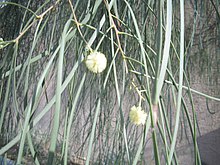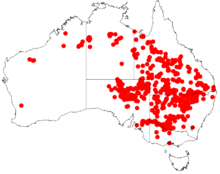Acacia stenophylla
| Acacia stenophylla | |
|---|---|

| |
| Scientific classification | |
| Kingdom: | Plantae |
| Clade: | Tracheophytes |
| Clade: | Angiosperms |
| Clade: | Eudicots |
| Clade: | Rosids |
| Order: | Fabales |
| Family: | Fabaceae |
| Subfamily: | Caesalpinioideae |
| Clade: | Mimosoid clade |
| Genus: | Acacia |
| Species: | A. stenophylla
|
| Binomial name | |
| Acacia stenophylla A.Cunn. ex Benth.
| |

| |
| Occurrence data from AVH | |
| Synonyms | |
Acacia stenophylla, commonly referred to as the shoestring acacia, is an evergreen tree in the family Fabaceae and native to Australia. It is not considered rare or endangered.[2]
Description[edit]
Acacia stenophylla varies in characteristic and size from a rounded, multi-stemmed shrub to a spreading tree.[3] A. stenophylla grows from 4–20 m (13–66 ft) tall,[3] often stemming into branches at the trunk from about 1 m (3.3 ft).[4] Bark is dark-grey to blackish and rough, branchlets are smooth to sericeous and sometimes angular.[3]
The phyllodes are strap-like, 15–40 cm (5.9–15.7 in) long, 2–10 mm (0.08–0.4 in) wide, straight to slightly curved, slightly rough, free from hair or very finely puberulous, acute to acuminate, apex is often strongly curved.[3] Veins are copious and closely parallel.[5]
The racemes are 3– to 5-headed, with stems 2–15 mm (0.08–0.6 in) long, which are slightly rough or with appressed minute hairs.[3] The peduncles are 6–13 mm (0.2–0.5 in) long.[3] The flower heads are creamy-white to pale yellow in colour, spherical and 6–9 mm (0.2–0.4 in) in diameter.[3] Flowers are pentamerous, with sepals three-quarters united.[3]
The pods are moniliform, up to 26 cm (10 in) long, 8–12 mm (0.3–0.5 in) wide, woody-leathery textured, smooth except micro-puberulous between seeds.[3] The seeds are longitudinal, elliptic, 7–9 mm (0.3–0.4 in) long, dark brown, lacking an aril, funicle enlarged, are folded at the seed apex.[3] Flowering time is often irregular, although mainly occurring in autumn.[3]
A. stenophylla is highly salt tolerant and moderately frost and drought tolerant.[6] The average minimum annual rainfall that the tree needs is around 400 mm (16 in) per year.[7]
Reproduction and dispersal[edit]
Acacia stenophylla normally flowers from March to August,[8] although it can flower irregularly throughout the year.[5][9] Seed pods turn woody as they mature from October to December and produce approximately 6–12 viable seeds/g.[6]
A. stenophylla seeds germinate prolifically.[10] After major floods, seedlings can often be present along the flood-line, but only a very small proportion of these persist.[11]
Taxonomy[edit]
Acacia stenophylla belongs to the genus Acacia, comprising 1200 species worldwide.[2] 900 of these species are endemic to Australia.[2]
Common names[edit]
Common names used in Australia include Balkura, Belalie, black wattle, Dalby myall, Dalby wattle, Dunthy, Eumong, Gooralee, Gurley, ironwood, Munumula, native willow, river cooba, and river myall.[1]
Etymology[edit]
The specific epithet is derived from the Greek stenos (narrow) and phyllon (leaf), meaning "with narrow leaves".[12]
Distribution[edit]
Acacia stenophylla is predominantly distributed in central and eastern Australia.[13]
A. stenophylla is found from the Murray River in South Australia and Victoria through western New South Wales, Northern Territory, and Queensland, with a small population also occurring in Western Australia.[13]
It mainly occurs from latitude 23° to 33° S[13] with a range from 17° to 36°S.[13] In altitude, it mainly occurs between 50 and 325 m[13] ASL with a range from near sea level to 625 m.[13]
Ecology[edit]
Climate[edit]
Acacia stenophylla is most commonly found in a warm arid climatic zone.[13] A. stenophylla tends to grow to a larger size in semiarid climates, which exist in New South Wales and Queensland.[13] The species also expands into the sub-humid zone in Queensland.[13]
Disregarding the species' far southern distribution, the mean maximum temperature of the warmest month is 35–38 °C and the mean minimum of the coolest month 4–7 °C.[13] There are, on average, about 110–130 days per year over 32 °C and 15–50 days over 38 °C.[6]
A. stenophylla is subject to 1–20 heavy frosts per year,[13] and withstands a variable rainfall frequency.[13] Rainfall is often augmented by groundwater or periodic flooding.[6]
Physiography and soils[edit]
Acacia stenophylla is common throughout the Interior Lowlands physiographic division.[13] It is often present on plains and gentle slopes and is common on the banks of watercourses, river flood plains, and depressions.[13] The soils are predominantly fine-textured alluvials, red sandy clay and grey cracking clays.[13] Soils often have a high pH and may be more saline in the lower horizons.[13]
Vegetation type[edit]
Acacia stenophylla occurs in ribbon-like stands along watercourses, often as a part of eucalyptus dominated open-forest, woodland or low woodland.[13] The species can be present in the understorey, often with Acacia salicina and Acacia pendula.[13] It can also occur alongside Eucalyptus populnea and Casuarina cristata, but commonly grows independently alongside watercourses in semiarid areas.[14]
Utilisation and uses[edit]
Acacia stenophylla is rarely utilised by cattle,[11] but it is palatable to sheep.[15] Seeds and pods of A. stenophylla were roasted and used by Indigenous Australians as a food source.[16]
The plant is said to contain medicinal alkaloids.[17]
A. stenophylla is widely planted as a drought tolerant and decumbent ornamental tree.[13] It is cultivated by plant nurseries, and used in modernist gardens and in public landscapes in the Southwestern United States and California.[citation needed]
Gallery[edit]
-
Acacia stenophylla, Macquarie Marshes
-
Bark
-
Seed pods, south of Moree
References[edit]
- ^ a b ILDIS LegumeWeb
- ^ a b c "Acacia stenophylla". www.anbg.gov.au. Retrieved 2020-10-21.
- ^ a b c d e f g h i j k "Flora of Victoria". vicflora.rbg.vic.gov.au. Retrieved 2020-10-20.
- ^ "Factsheet - stenophylla". worldwidewattle.com. Retrieved 2020-10-20.
- ^ a b Schmid, Rudolf; Walsh, N.G.; Entwisle, T.J. (May 2000). "Flora of Victoria. Vol. 4. Dicotyledons: Cornaceae to Asteraceae". Taxon. 49 (2): 344. doi:10.2307/1223869. ISSN 0040-0262. JSTOR 1223869.
- ^ a b c d Marcar, N.; Crawford, D.; Leppert, P.; Jovanovic, T.; Floyd, R.; Farrow, R. (1995). Trees for Saltland. doi:10.1071/9780643101425. ISBN 978-0-643-10142-5.
- ^ Skeen, Max (May 2009). "Dryland Area Species". Archived from the original on 2006-08-23.
- ^ Schmid, Rudolf; Harden, Gwen J. (August 1992). "Flora of New South Wales". Taxon. 41 (3): 627. doi:10.2307/1222862. ISSN 0040-0262. JSTOR 1222862.
- ^ Schomburgk, Richard (1878). Catalogue of the plants under cultivation in the Government Botanic Garden, Adelaide, South Australia. Adelaide: W.C. Cox. doi:10.5962/bhl.title.54333.
- ^ "Lithgow, David Cunningham", Benezit Dictionary of Artists, Oxford University Press, 2011-10-31, doi:10.1093/benz/9780199773787.article.b00110463
- ^ a b Cunningham, G.M.; Mulham, W.E.; Milthorpe, P.L.; Leigh, J.H. (2011). Plants of Western New South Wales. doi:10.1071/9780643104273. ISBN 9780643104273.
- ^ "Plantillustrations.org Epithet: stenophyllus,-a,-um". Archived from the original on December 3, 2018. Retrieved 3 December 2018.
- ^ a b c d e f g h i j k l m n o p q r s Cole, Trevor J. (1981). Planting trees and shrubs. Ottawa: Agriculture Canada. doi:10.5962/bhl.title.59091. ISBN 0-662-10286-X.
- ^ Pedley, L (1992). "Corrigenda — A further note on Acacia aneura (Mimosoideae : Leguminosae)". Australian Systematic Botany. 5 (6): 767. doi:10.1071/sb9920767c. ISSN 1030-1887.
- ^ Manifold, C. B. (April 1948). "The Use and Misuse of Shrubs and Trees as Fodder". Geographical Review. 38 (2): 342. doi:10.2307/210871. ISSN 0016-7428. JSTOR 210871.
- ^ Cribb, Philip; Winterringer, G.S.; Sheviak, C.J. (1976). "Wild Orchids of Illinois". Kew Bulletin. 31 (1): 200. doi:10.2307/4109021. ISSN 0075-5974. JSTOR 4109021.
- ^ "Lycaeum". Archived from the original on 2007-09-30. Retrieved 2007-06-18.



